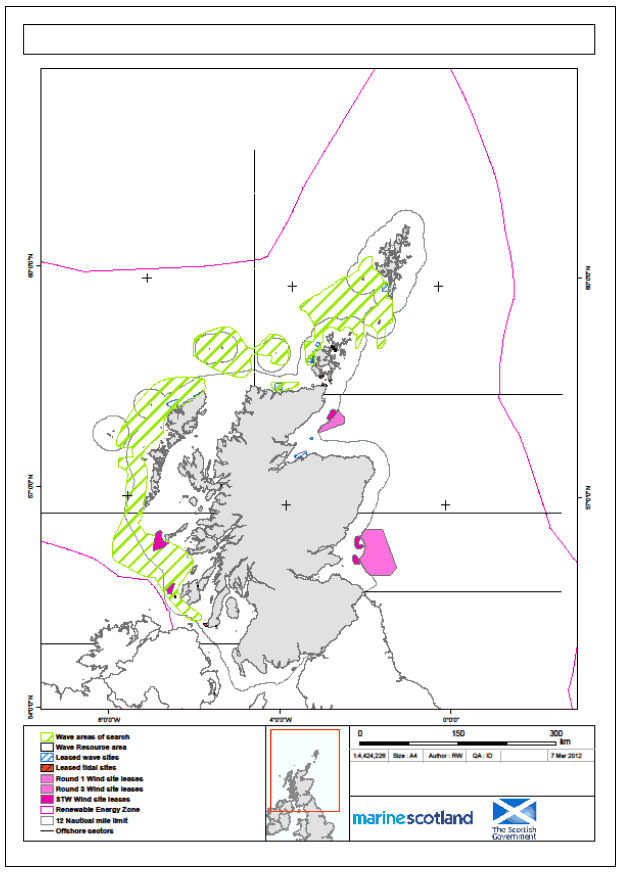Scottish Marine and Freshwater Science Volume 3 Number 2: Scoping Study For Offshore Wave Energy Development In Scottish Waters
Scoping Study For Offshore Wave Energy Development In Scottish Waters
Executive Summary
The Scottish Government has set a range of challenging targets for energy and climate change. These recognise the potential to take advantage of the extensive marine energy resources (wind, wave and tidal power) available in Scottish waters and include meeting at least 30% of total energy demand from renewable sources by 2020, incorporating:
- 100% of electricity demand from renewables (31% by 2011)
- 11% of heat demand from renewables
- 10% of transport fuel from renewables
In addition, the Climate Change (Scotland) Act 2009 sets statutory targets of at least 42% emissions cuts by 2020, and at least 80% by 2050.
To assist in meeting these targets, the Scottish Government has adopted an iterative approach to marine planning for the renewable energy sectors. A Sectoral Marine Plan for Offshore Wind Energy in Scottish Territorial Waters (Blue Seas - Green Energy) sets out the Government's vision for developing offshore wind energy up to 2020 and beyond and has identified short term development sites for offshore wind up to 2020, with a potential to deliver almost five Gigawatts ( GW) of electricity generation capacity. A new Scoping Study extends the potential development area out to 200 nm.
A sensitivity analysis of the process used to develop the offshore wind Plan concluded that, as additional data and monitoring information and improved data handling procedures become available, these should be incorporated into the emerging iterative marine planning process.
A process was therefore put in place by Marine Scotland to develop a Scoping Report for the potential for wave energy development in Scottish waters out to 200 nautical miles, building on the Scoping Study undertaken for the Saltire Prize (Harrald and Davies, 2010). This report describes the process employed by Marine Scotland in collaboration with The Crown Estate to develop a series of new wave energy plan options within Scottish marine waters.
The Crown Estate spatial modelling tool MaRS was used to create multi-factorial expressions of the technical opportunities and constraints on offshore wave energy development in Scottish waters, and of the constraints on consenting presented by themed groups of factors. These themes reflect current commercial (industrial) activities such as fishing, aquaculture and offshore oil and gas, environmental factors such as designated Natura sites and the distributions of certain sensitive species, and a broad field of "socio-cultural" interests including recreational uses, archaeological potential, visual and landscape factors. These models have been combined and used to develop overall expressions of the relative degrees of constraint. The sensitivity of the process was investigated through the creation of a series of combined models altering the relative influence of each the themes. Considerable similarities were found between the combined models, and the model that weights the three themes equally was taken forward and used to develop plan options for wave energy developments within Scottish Territorial Waters ( STW).
Figure S1 Areas of search for offshore wave plan option areas identified within Scottish marine waters, and marine renewable energy development areas currently within the Marine Scotland Marine Licence process.

Consideration of the resource areas, and the constraints on development arising from environmental, industry and socio-cultural factors discussed above, lead to the identification of four areas of search for wave energy development options in Scottish waters ( Figure S1). The areas are limited to areas where wave energy is >20 kw/m in water depths of less than 90m, to broadly reflect the depths for which developer interest is currently being expressed. The areas are:
A. West of the Hebrides
B. North West of Cape Wrath
C. Orkney and Shetland
D. North Sutherland coast
The geographical extent of these areas A - C is large enough for there to be opportunities for fully commercial scale development of wave energy projects. Area D is relatively small and close to the boundary of the resource area. The resource areas, and areas of search, for wave energy developments occur both within and beyond Scottish Territorial Waters. In detail, there is variation between low and moderate levels of constraint within these broad areas, and more detailed assessment through Regional Locational Guidance will be required to derive plan options for wave energy.
This analysis should not be taken to imply that there are no useful wave resource areas elsewhere around Scotland. The identification of resource areas has been based upon wave energy maps taken from the DECC Renewables Atlas ( DECC, 2008). The wave information in that Atlas is presented as a grid of data, with cell size of 1.8 km. Resource areas smaller than this may well not be represented, and uncertainties in the boundaries of resource areas up to the scale of a few cells, or immediately adjacent to the coast, may be poorly represented. It is also likely that some smaller wave energy devices may be able to function economically in areas of less than 20 kw/m available energy. Such areas will not have been captured by this scoping study, but in favourable locations may offer considerable potential for small (and perhaps medium) scale developments for testing or commercial purposes.
The outputs from this study will inform the marine planning process by leading to the development of Regional Locational Guidelines for wave energy development, which in turn will be the basis for the Sustainability Appraisal to cover tidal stream energy development in Scottish waters. This process involves Strategic Environmental Assessment ( SEA), Habitats Regulations Appraisal, Socio-economic Assessment, as well as statutory consultation with key sectors, stakeholders and the wider public.
Contact
There is a problem
Thanks for your feedback